Food and Drink in Egypt
Introduction
Egyptian food combines elements of Lebanese, Turkish, Syrian, Greek, and French cuisines, modified to suit local conditions and tastes, with more Mediterranean influences, such as Alexandria and spicy Nubian cooking in the south. Vegetables, meats, aromatic herbs, and spices are combined to create colorful dishes. Typically, a meal starts with soup made from pulses or beans, onions, tomatoes, and leafy green vegetables. A large helping of garlic or spices kicks them. A dish of meats slow-roasted with herbs, or couscous or rice may follow. Meals are almost always served with salad, dips, and bread. Desserts, particularly pastries made using gs, nuts, and dates and smothered in honey, are typical, as is yogurt. If you are concerned about what to eat in Egypt during your upcoming Egyptian vacation in the Land of the Pharaohs, you need not be. It would be virtually impossible for anyone to visit Egypt without discovering countless culinary delights that are downright delicious, and the more adventurous you are willing to be, the more rewarding your culinary journey will be.
Rules of Etiquette
Egyptians are amiable and fantastic hosts. Remember a couple of vital self-defense tips to survive an invitation to eat in an Egyptian house. First, your host must see that you’re well-fed, and well-fed people do not leave an empty plate in front of them. It is fatal, therefore, to try to do as you were told as a child and clean your plate. However much you protest, it will be filled again. Rule number one: When you don’t want more food, leave your plate half-full and push it away. Rule number two is only to eat half the food on your plate- make a space and refill it. This allows you to control the supply. Egyptians tend not to drink while eating, but they’ll often finish with something sweet, like a soft drink. You may have to alert your host if you need to wash down your food. Don’t be afraid to ask. Guests who ask will receive it copiously. Being on time isn’t very important. Showing up at least 15 minutes after the appointed time is expected. However, be sensitive to the fact that because you’re a foreigner, an effort will probably be made to start at the appointed time. Double-guessing like this is inevitable and causes great confusion and hilarity. Showing up with a gift is essential. Flowers are perfect, chocolates are great, and even a bottle of wine is fine, but only if you visit a Christian household.
Street Food
Egypt’s staples are bread (‘aish, which means “life”), fuul and taamiya. Bread, eaten with all meals and snacks, comes either as pitta-type ‘aish Shamsi (sun-raised bread made from white flour) or ‘aish baladi (made from coarse wholewheat flour).
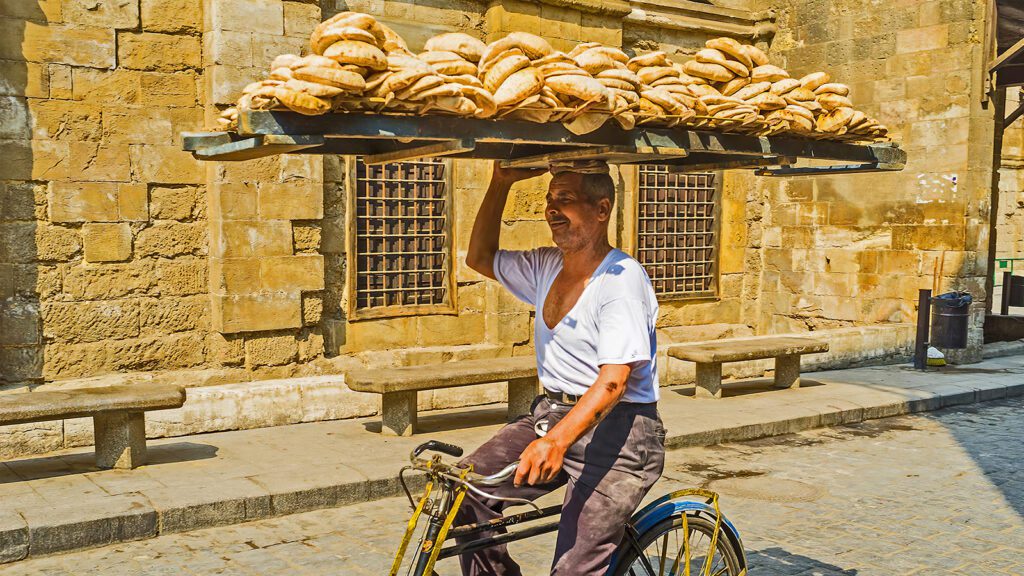
Fuul (pronounced “fool”; fava beans) is extremely cheap and can be prepared in several ways. Boiled and mashed with tomatoes, onions and spices, it becomes fuul madammes, often served with a chopped boiled egg for breakfast. A similar mixture stuffed into ‘aish baladi constitutes the fuul sandwiches sold on the street. Taamiya (falafel) is deep-fried patties of spiced green beans, usually served in pitta bread with salad, pickles and tahina (a sauce made from sesame paste), for which you can expect to pay the grand sum of 1-2€. Another cheap café perennial is makarona – macaroni baked into a cake with minced lamb and tomato sauce. It’s rather bland but very filling. Similarly common is kushari, a mixture of noodles, rice, macaroni, lentils and onions, in a spicy tomato sauce (another sauce, made of garlic, is optional). It’s served in small, medium and large portions (5-6€) in tiled stand-up diners, called kushari.
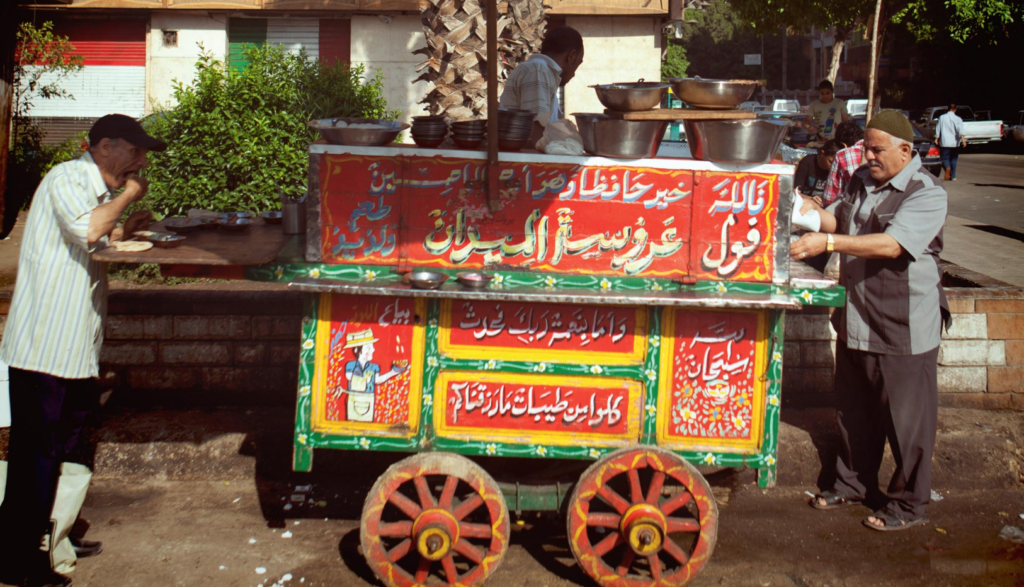
Fiteer, a cross between pizza and pancake, consists of flaky filo pastry stuffed with white cheese, peppers, mince, egg, onion and olives, or with raisins, jams, curds or a dusting of icing sugar, costs 5-15€ (depending on size and ingredients) at café-like establishments known as fatatri. Most sandwiches are small rolls with a minute portion of basturma (pastrami) or cheese. Other favourite fillings include grilled liver (kibda) with spicy green peppers and onions; tiny shrimps; and mokh (crumbed sheep’s brains). A common appetizer is torshi, a mixture of pickled radishes, turnips, gherkins and carrots; luridly coloured, it is something of an acquired taste, as are pickled lemons, another favorite. Lastly, there’s shawarma – slices of marinated lamb, stuffed into pitta bread or a roll and garnished with salad and tahina – somewhat superior to the similar-looking doner kebabs sold abroad. A shawarma sandwich from a street stall can cost as little as 5-7€, while a plate of shawarma in a cheap diner will set you back around 10€. On the hygiene front, while cafés and tiled eateries with running water are generally safe, street grub is highly suspect unless it’s peelable or hot.
Restaurant meals
The classic Egyptian restaurant meal is a lamb kebab or kofta (spiced mince patties), accompanied or preceded by a couple of mezze (salads and dips) – usually hummus (made from chickpeas), tahina and babaghanoug (tahina with aubergine). Many restaurants sell kofta and kebab by weight: a quarter of a kilo is one portion, while a full kilo is usually enough for three to four people. Chicken (firakh) is a standard, both in cafés and as takeaway food from spit-roast stands. Pigeon (hamam) is common too, often served with freek (spicy wheat) stuffing. There’s not much meat on a pigeon, so it’s best to order a couple each. In slightly fancier places, you may also encounter pigeon in a tageen or ta’gell, stewed with onions, tomatoes and rice in an earthenware pot. A meal in an inexpensive restaurant should set you back around 20-30€ per person.
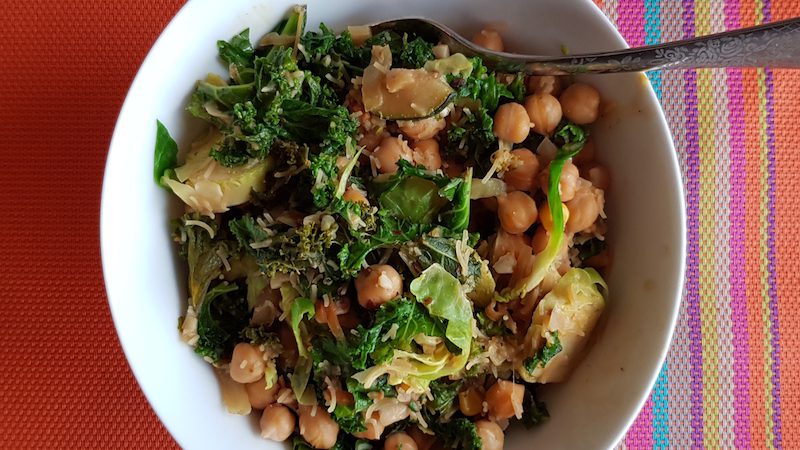
Posher restaurants offer a larger selection of mezze, often including olives and stuffed vine leaves, as well as soups, and dishes such as molukhiyya (Jew’s mallow stewed in stock – a lot tastier than its disconcertingly slimy appearance suggests), mahshi (stuffed vegetables), and torly (mixed vegetable casserole with lamb or occasionally beef). Fish (samak) – including sea bream, snapper, Nile perch, squid and prawns – is particularly good in Alexandria, Aswan, the Red Sea Coast and Sinai. You often pick your own from an ice box, priced by weight, then grilled or fried, and served with salad and chips. Confusingly, pasta, rice, chips (French fries) and even crisps (potato chips) are often considered interchangeable – so you may order rice and get chips instead. Also note that the shaker with one hole is for pepper, the one with several holes for salt.
Snacks, sweets and fruit
There are two main types of cheese: gibna beyda (white), which tastes like Greek feta, and gibna rumi (“Roman”), a hard yellow cheese tasting a bit like Edam. For breakfast you will often be given imported processed cheeses such as La Vache Qui Rit (“The Laughing Cow” – a popular nickname for ex-president Mubarak). Nut shops (ma’la) are a street perennial, offering all kinds of peanuts (fuul sudani) and edible seeds. Lib abyad and lib asmar are varieties of pumpkin seeds, lib battikh come from watermelon, and chickpeas (hummus) are roasted and sugar-coated or dried and salted; all of these are sold by weight. Most nut shops also stock candies and mineral water.
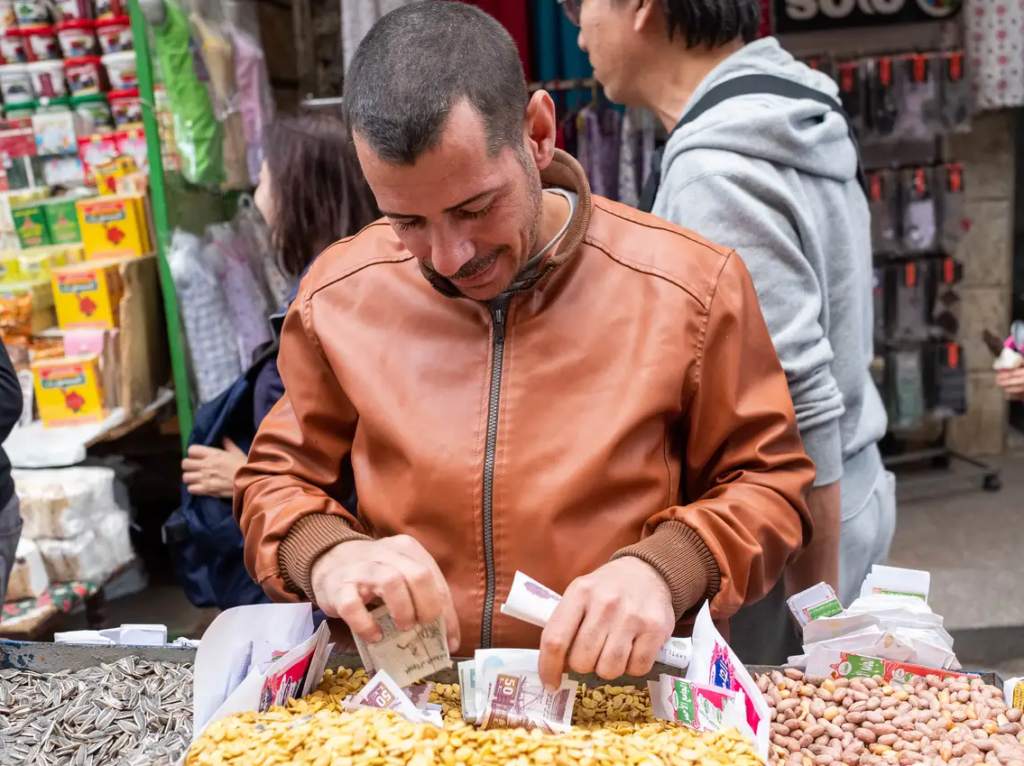
Cakes are available at patisseries (some attached to quite flash cafés) or street stalls. The classics include baklava (filo pastry soaked in honey and nuts – called basbousa in Upper Egypt, though elsewhere the term usually applies to syrup-drenched semolina cake); katif (similar but with shredded wheat); and a variety of milk- or cornflour-based puddings, such as mahalabiyya (blancmange) and Umm Ali (made with pastry, milk, sugar, coconut and cinnamon, usually served hot). Fruits are lovely in Egypt, readily available at street stalls, or pressed into juice at juice bars. In winter there are oranges, bananas and pomegranates, followed by strawberries in March. In summer, you get mangoes, melons, peaches, plums, and grapes, plus a brief season (Aug & Sept) of prickly pears (cactus fruit). Fresh dates are harvested in late autumn. Only apples are imported and thus expensive.
Drinks
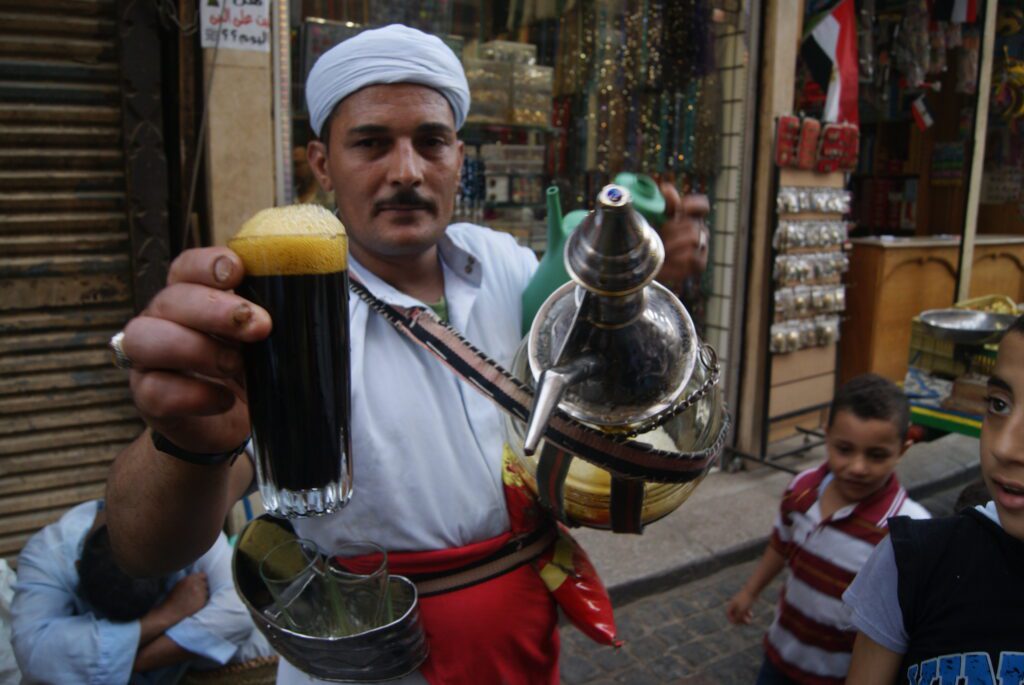
As a predominantly Muslim country, Egypt gives alcohol a low profile. Public drunkenness is unacceptable, and sale of alcohol is prohibited on the Prophet Mohammed’s birthday and – except for a few places serving tourists – during the month of Ramadan. Egypt’s national beverage is tea (shai). Invitations to drink tea (shurub shai?) are as much a part of life in Egypt as in Britain, although it is served quite differently, generally prepared by boiling the leaves, and served black and sugared to taste (though an increasing number of cafés use tea bags and may supply milk). Tea with milk is shai bi-laban, tea-bag tea is shai libton – to avoid it ask for loose-leaf tea (shai kushari). Tea with a sprig of mint (shai bi-na’ana’) is refreshing when the weather is hot. Coffee (’ahwa) is traditionally Turkish coffee, served in tiny cups pre-sugared to customers’ specifications: saada (unsugared), ‘ariha (slightly sweetened), mazboota (medium sweet) or ziyaada (syrupy). In some places you can get it with cardamom (’ahwa mahawega). Most middle-class or tourist establishments also serve instant coffee, with the option of having it with milk (’ahwa bi-laban). Upmarket places increasingly have espresso machines.
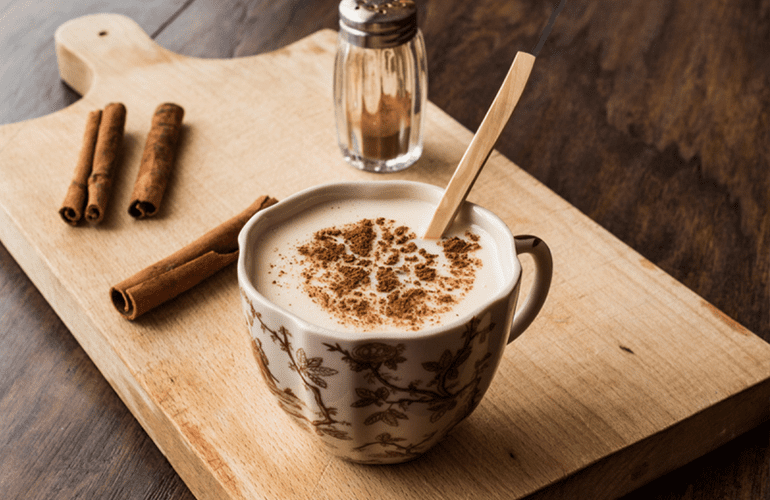
Traditional coffee houses (’ahwa) are usually shabby hole-in-the-wall places with chairs overlooking the street. Until very recently, it was unusual for women to frequent ’ahwas and unheard of to see them puffing away on a sheesha, but times change, and in more upmarket establishments, younger, less inhibited women can now be seen with a waterpipe to their lips. Foreign women won’t be turned away from ’ahwas but may feel uneasy, especially if unaccompanied by a man. For a more relaxed tea or coffee, try one of the middle-class ’ahwas found in larger towns and often attached to patisseries.
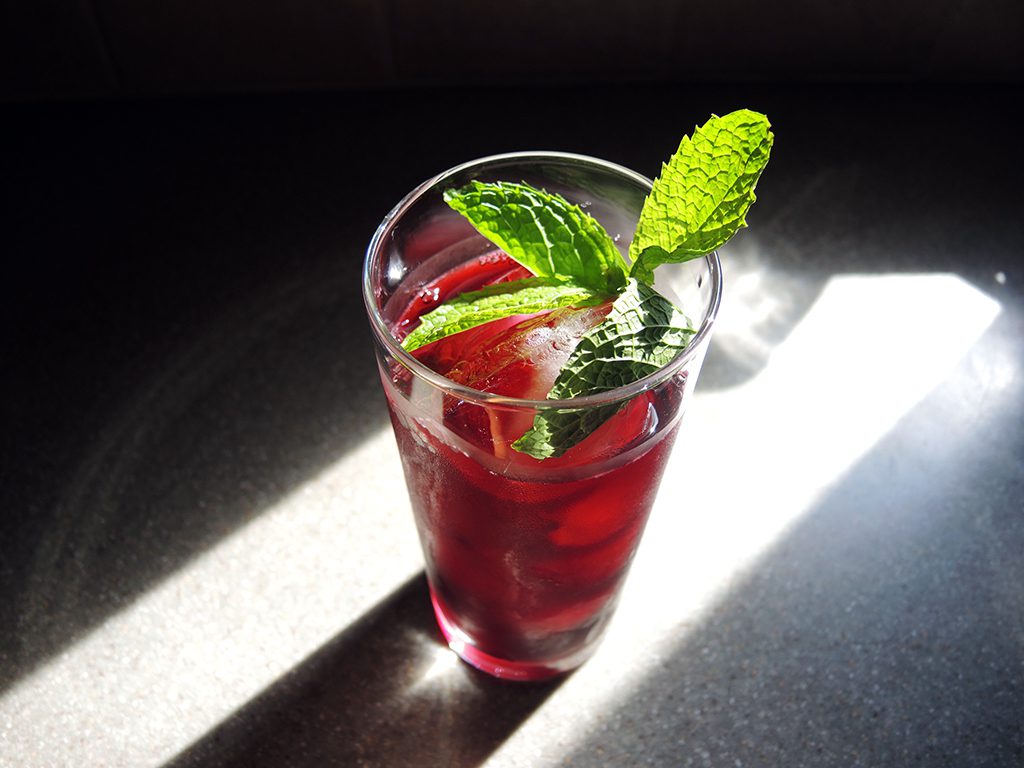
Karkaday (or karkadé) is a deep-red infusion of hibiscus flowers. Most popular in Luxor and Aswan, it is equally refreshing to drink hot or cold. Elsewhere, they may use dehydrated extract instead of real hibiscus, so it doesn’t taste as good. Other infusions sold in ’ahwas include helba (fenugreek), yansoon (aniseed) or ’irfa (cinnamon). On cold winter evenings you might enjoy sahleb, a thick, creamy drink made from milk thickened with ground orchid root, with cinnamon and nuts sprinkled on top. In hot weather Egyptians imbibe rayeb (soured milk), which is something of an acquired taste.
Alcohol
Alcohol can be obtained in most places, but outlets are limited. In the Western Desert oases or Middle Egypt, sale is prohibited or severely restricted. If there are no bars, then hotels or restaurants are the places to try; if you can’t see anyone drinking it, there’s none to be had. Keep in mind that the hot, dry climate can lead to dehydration, and agonizing hangovers can easily result from overindulgence.
Beer, whose consumption goes back to pharaonic times, is the most widely available form of alcohol. Native Stella beer is a light lager (4 percent ABV) which is OK if it hasn’t sat in the sun for too long. To check that bottled beer hasn’t gone flat, invert the bottle before opening and look for a fizzy head. Stella retails in liquor stores for 7€, and in most bars for 8-10€, though discos may charge as much as 30€, and cruise boats even more. Sakkara is a similarly light lager (4 percent) that most foreigners seem to prefer. Premium or “export” versions of Stella and Sakkara have a slightly fuller flavor. Also worth trying is the Luxor lager, available in “classic” (5 percent) or “gold” (4.7 percent) varieties. There’s also a locally brewed Heineken, plus kamikaze (7–10 percent) versions of Sakkara and Meister, which are worth avoiding. Marzen, a dark bock beer, appears briefly in the spring; Aswali is a dark beer produced in Aswan. There is also Birrel, a non-alcoholic beer.
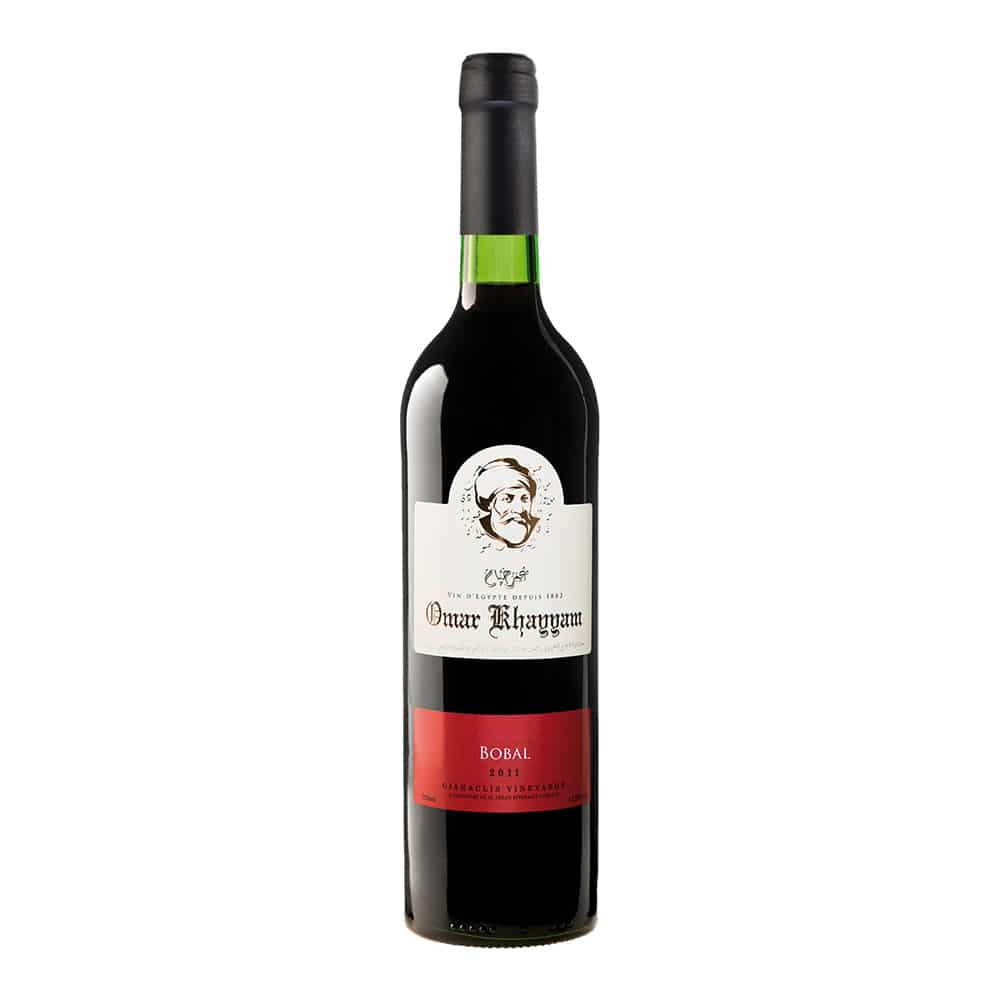
A half-dozen or so Egyptian wines, produced near Alexandria, include Omar Khayyam (a very dry red), Cru des Ptolémées (a dry white), and Rubis d’Egypte (a rosé). None are perfect, though Obélisque Red Cabernet Sauvignon and Chateau des Rêves are slightly better than most. These retail for about €80 a bottle in most restaurants but more like €120 on a cruise boat. Spirits are usually mixed with sodas or fruit juice. The favorite is brandy, known as jaz (“bottle”), and sold under three labels: Ahmar (the cheapest), Maa’tak (the best), and Vin (the most common). Zibiba is similar to Greek ouzo. Avoid vile Egyptian-made gin and whisky whose labels imitate famous Western brands – they may contain wood alcohol and other poisons. A vodka-based alcopop called ID is available in various flavors at liquor stores, some bars, and duty-free shops.
The sheesha

The sheesha, or waterpipe, is inseparable from Egyptian café society. It takes ma’azil, rough tobacco with molasses, whose distinctive aroma is guaranteed to take you right back to Egypt if you smell it again elsewhere. Posh coffee houses may also stock other flavors of tobacco (apple, strawberry, mint, and so forth) and provide disposable plastic mouthpieces. A sheesha is usually shared among friends, but you can decline to partake without offending. Please don’t call it hubbly-bubbly, as in Egypt; the term refers to smoking hashish.
Vegetarian eating
Most Egyptians eat vegetables mostly – meat and fish are luxuries – yet the concept of vegetarianism is incomprehensible. Even if you say that you‘re vegetarian (in Arabic, ana nabati if you’re male, ana nabatiya if you’re female) people may offer you chicken or fish as a substitute. Still, vegetarians and vegans will have no trouble feeding themselves in kushari and falafel joints, and fatatris offer reasonable pickings too, even for vegans (who can try ordering a veg or mushroom fiteer without cheese). Restaurants and hotels that cater mainly to tourists often feature a few vegetarian dishes on the menu, such as omelets, vegetable tagines, pasta, and salads. For vegans, the magic word is siami, which means “for fasting”. Coptic Christians have a vast number of fast days in which they eat no meat, fish, eggs, or dairy products, and siami versions of many dishes are available for their benefit. Thus a siami pizza, for example, is one without cheese.










